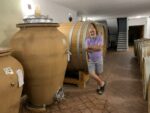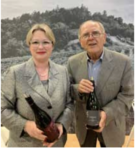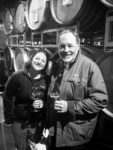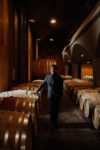Château Beychevelle is a Médoc property located in AOC Saint-Julien and which was recognized in 1855 as a 4th Grand Cru Classé. This winery has a rich history with roots in the mid 16th century.
The first castle was built in 1565 by Bishop François de Foix-Candale whose niece inherited the property and was married to the Duke d’Epernon. Of course at the time there was certainly vines, but the estate was not geared only towards this activity and was then managed in mixed farming. Subsequently it was partly destroyed only to be rebuilt in 1757 by the Marquis de Brassier. He was one of the main architects of the vineyard and of the renown of Beychevelle wines at the time. Following the French Revolution the property was seized and then sold at auction. It was later bought by a branch of the Brassier family to be sold later. Then the property changed hands three times before being acquiered by Achille-Fould family who worked enormously for the qualitative recognition of Beychevelle wines. The estate remained within this family until the death of Aymar Achille Fould in 1986. At the time, it was acquired by the Japanese spirits group Suntory and by GMF.
In 2010 the shareholding changed with the arrival of the Castel group, which acquired 50% of Château Beychevelle and the rise of Suntory, also now at 50%. Following this arrival, a major project to create a new vat room was launched in order to give Beychevelle and her team a cutting- edge tool to meet their work requirements. After seven long years of reflection and work, the new cellar is inaugurated. Currently the property extends over 94 hectares of which 80 are in AOC Saint-Julien and 14 in Haut-Médoc. On average, Château Beychevelle produces 20,000 cases of Grand Vin (around 240,000 bottles) and 150,000 bottles of L’Amiral de Beychevelle annually. ”We work a lot to produce, on average 60% of Grand Vin each year. In 2014 we were more around 70% ”
We invite you to go together to meet this property and its Managing Director, Mr. Philippe Blanc.
Where does the name of the property come from ?
Philippe Blanc: We owe this name to Jean-louis Nogaret de la valette, duke of Epernon, governor of guyenne and above all grand Admiral of the french Royal Navy (Henri iii). The name Beychevelle comes from the contraction of the gascon words ‘ Beych ‘ which means ‘lower’ and ‘ velle ‘ the sail… therefore ‘Bateau which lowers the sail’. This name refers to the ancient tradition of the sailors who joined the Port de la lune (Bordeaux) and who lower the sail while passing in front of the property, a tradition marking respect for the great man or a requirement of the grand Admiral. The legend is not very clear on this point… However, the fact is that the ships lowered their sails. We also find this story through our label. Some see it as a drakkar, others a chinese boat, but it is in fact a barge (typical boat of the gironde) decked out with a griffin. The latter is a nod to the keeper of the wine crater of King dionysus, god of wine among the Romans.
If you had to describe in a few words what is the spirit of Beychevelle , the team and its wine , what would you say ?
P.B.: it was during my agronomy studies that i discovered viticulture. it quickly fascinated me as much by the practice, the culture of the vine, the wine, the symbolic scope of the product as by the extent of the possibilities and the things to do. in wine there are values, a history and a close link with our culture that i personally do not find in milk or wheat. As far as my arrival at château Beychevelle is concerned, it happened by chance. One of my former promotion colleagues was to come to the property. coincidentally, a last minute event meant that he could not take the job. So he was kind enough to let me know, i applied and i was hired. Since that day i have felt a sense of happiness and a certain honor to occupy this position of general Manager.
By training i am therefore a technician. i certainly had a role of cEO, but i was also very often in the technical field because in 1995 we did not have a large team like today. There was only one cellar Master, a culture manager with all the qualities and limitations of the time. We then worked to enrich and expand the team with more qualified people or even more qualified thanme. it allowed me to delegate as i went. Today, 20 years later, i still have a technical fiber, this is still what i like and what fascinates me in this profession… it is my reason for being.
How do you recognize Château Beychevelle wines blindly ?
P.B.: it’s a difficult question and an exercise that requires a lot of humility. i don’t think it’s possible to systematically find your wine in a shelf… We look for it systematically, sometimes we find it but honestly i am very humble about the tasting because we are so often wrong, we may be more often wrong. So i am really very careful… i would say we try to have systematically in each of our vintages : elegance, concentration, of harmony, a wine balanced… More simply seeking to make good wines and that makes you want to drink. We are certainl y not the only one to do it , to seek it… is this is what will bring out a tasting, blind, Saint-Julien ? i dare to hope not…
Personally I would add that a nice controlled power, a gravely / fresh racy side , a strong presence of Merlot at 45/51% (while we are on the left bank) as well as a nice quality of the fruit are also advantages. An other important markers for the property it’s a certain richness of tannins.
What are the peculiarities and strengths of the terroirs of Château Beychevelle ?
P.B.: Most of the plots that make the grand vin de Beychevelle are located on two plateaus (located at a low altitude) of deep garonnaise gravels from the güntz era on a clay subsoil. The first is the southern plateau which starts from the national road to our illustrious neighbor. The second is a plateau located to the north of the winery, it is our jewel! it extends to the bottom of château léoville- Barton. it is the grapes from these two plateaus that makeup almost all of our grand vin. Here again, this demystifies the role and the magic of blending because overall everything that is produced on its two large groups goes into the
first wine… This is also the beauty of our terroir is that each year it does not. there is no need to wonder if we are goingto take 25%, 50% or 75% of our plots but 100%… We are used to saying that if we had only had this plot we would have not classified as a 4 th grand cru classé but as a second.
These two blocks have been part of the property since 1855. Our plot has changed little since the classification… We had to increase by a maximum of 20/25% and most of the time it was to make our second more complex, to work on our second label (Admiral de Beychevelle ). This wine is not conceived as a second wine but as a real second label, with its own identity, its qualities, its DNA… it is not, like what was done in Bordeaux a few years ago, the wine in which ‘we put what remains or the young vines’. We have a specific vineyard dedicated to this nectar… with an average age of the vines of 35 years. We work a lot on this wine… and we are also very proud of it. This is one of our big developments over the past 25 years.
Do you have any plans for Château Beychevelle ?
P.B.: No, we don’t really have any short term plans at the moment. But we worked on the internal things such as communication, the picture of the human… in the long term what interests me is agroforestry. it’s absolutely incredible, but not easy to implement.
Do you have an anecdote about the property ?
P.B.: My anecdote is going to be classic, but i would say that every day it is a great pleasure to be on this property, to meet people that i would not have been able to meet by being at a yogurt store or whatever. for me, it’s part of the happiness that the job gives us. There are a lot of people who tell me that they discovered Bordeaux wine with Beychevelle… it is a real pride for us ! it is also an incredible motivation for me.
Thanks to Philippe Blanc and Géraldine Marquay-Santier for their warm welcome. – J.C.C.
Château Beychevelle
33250 Saint-Julien-Beychevelle – France
www.beychevelle.com




